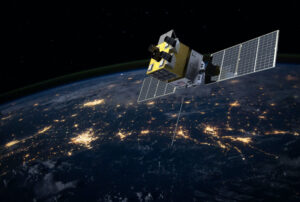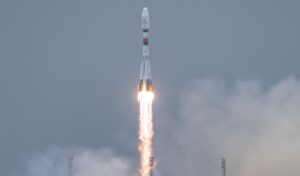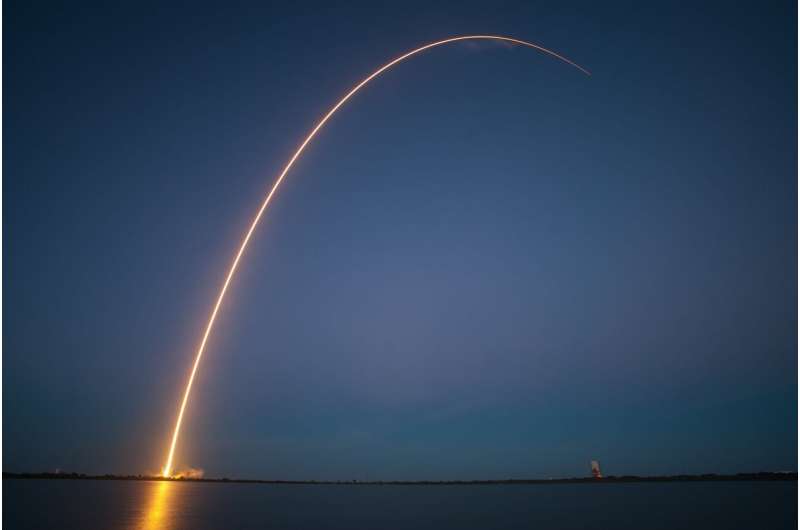NASA Selects Futuristic Space Technology Concepts for Early Study
Sunday, 27 February 2022 02:27 An astronaut steps into a body scanner and, hours later, walks on Mars in a custom-made spacesuit, breathing oxygen that was extracted from Mars' carbon dioxide-rich atmosphere. On Venus, an inflatable bird-like drone swoops through the sky, studying the planet's atmosphere and weather patterns. Ideas like these are currently science fiction, but they could one day become reality, thanks to a ne
An astronaut steps into a body scanner and, hours later, walks on Mars in a custom-made spacesuit, breathing oxygen that was extracted from Mars' carbon dioxide-rich atmosphere. On Venus, an inflatable bird-like drone swoops through the sky, studying the planet's atmosphere and weather patterns. Ideas like these are currently science fiction, but they could one day become reality, thanks to a ne How to reach a tumbling target in space
Sunday, 27 February 2022 02:27 In 2002, the European Space Agency launched Envisat, the largest civilian satellite (at the time) to go to low Earth orbit (LEO). For a decade, it observed our planet and sent back valuable data on Earth's climate, tracking the decline of Arctic sea ice and more, until it went dark in 2012.
One of the prevailing theories for its demise is that it simply ran out of fuel. As LEO becomes more
In 2002, the European Space Agency launched Envisat, the largest civilian satellite (at the time) to go to low Earth orbit (LEO). For a decade, it observed our planet and sent back valuable data on Earth's climate, tracking the decline of Arctic sea ice and more, until it went dark in 2012.
One of the prevailing theories for its demise is that it simply ran out of fuel. As LEO becomes more China's new-generation manned launch vehicle may have reusable first stage: report
Sunday, 27 February 2022 02:27 China's new-generation manned launch vehicle may have a reusable first stage that can make a vertical soft landing, Science and Technology Daily reported Friday.
The reusable first stage can perform engine deceleration during the reentry, and control itself and decelerate by pneumatic rudders, said Wang Xiaojun, head of the China Academy of Launch Vehicle Technology, which is under China A
China's new-generation manned launch vehicle may have a reusable first stage that can make a vertical soft landing, Science and Technology Daily reported Friday.
The reusable first stage can perform engine deceleration during the reentry, and control itself and decelerate by pneumatic rudders, said Wang Xiaojun, head of the China Academy of Launch Vehicle Technology, which is under China A Astronaut Matthias Maurer marks his first 100 days in space
Sunday, 27 February 2022 02:27 Happy 100 days in space to ESA astronaut Matthias Maurer. The first-time space flier marked the milestone on 19 February 2022 and what a busy 100-days it been.
In a Twitter post marking the milestone, Matthias wrote, "100 days may sound like a lot, but it feels like I've only just arrived."
Even before launching for his Cosmic Kiss mission on a SpaceX Dragon as part of Crew-3, Matthi
Happy 100 days in space to ESA astronaut Matthias Maurer. The first-time space flier marked the milestone on 19 February 2022 and what a busy 100-days it been.
In a Twitter post marking the milestone, Matthias wrote, "100 days may sound like a lot, but it feels like I've only just arrived."
Even before launching for his Cosmic Kiss mission on a SpaceX Dragon as part of Crew-3, Matthi Scientists reveal 4.4 million galaxies in a new map
Sunday, 27 February 2022 02:27 Durham University astronomer collaborating with a team of international scientists have mapped more than a quarter of the northern sky using the Low Frequency Array (LOFAR), a pan-European radio telescope.
The map reveals an astonishingly detailed radio image of more than 4.4 million objects and a very dynamic picture of our Universe, which now has been made public for the first time.
Durham University astronomer collaborating with a team of international scientists have mapped more than a quarter of the northern sky using the Low Frequency Array (LOFAR), a pan-European radio telescope.
The map reveals an astonishingly detailed radio image of more than 4.4 million objects and a very dynamic picture of our Universe, which now has been made public for the first time. New evidence proves acceleration of quasar outflows at scale of tens of parsecs
Sunday, 27 February 2022 02:27 Dr. HE Zhicheng and his coworkers from the University of Science and Technology of China (USTC) of the Chinese Academy of Sciences created a new way to measure the physical properties of galactic ionized gas, and discovered the acceleration of quasar outflows at the scale of tens of parsecs for the first time. Their paper was published on Science Advances
According to modern theories on ga
Dr. HE Zhicheng and his coworkers from the University of Science and Technology of China (USTC) of the Chinese Academy of Sciences created a new way to measure the physical properties of galactic ionized gas, and discovered the acceleration of quasar outflows at the scale of tens of parsecs for the first time. Their paper was published on Science Advances
According to modern theories on ga Webb Mirror Alignment continues successfully
Sunday, 27 February 2022 02:27 Webb continues on its path to becoming a focused observatory. The team has successfully worked through the second and third out of seven total phases of mirror alignment. With the completion of these phases, called Segment Alignment and Image Stacking, the team will now begin making smaller adjustments to the positions of Webb's mirrors.
After moving what were 18 scattered dots of starligh
Webb continues on its path to becoming a focused observatory. The team has successfully worked through the second and third out of seven total phases of mirror alignment. With the completion of these phases, called Segment Alignment and Image Stacking, the team will now begin making smaller adjustments to the positions of Webb's mirrors.
After moving what were 18 scattered dots of starligh Deep neural network to find hidden turbulent motion on the Sun
Sunday, 27 February 2022 02:27 Scientists developed a neural network deep learning technique to extract hidden turbulent motion information from observations of the Sun. Tests on three different sets of simulation data showed that it is possible to infer the horizontal motion from data for the temperature and vertical motion. This technique will benefit solar astronomy and other fields such as plasma physics, fusion science,
Scientists developed a neural network deep learning technique to extract hidden turbulent motion information from observations of the Sun. Tests on three different sets of simulation data showed that it is possible to infer the horizontal motion from data for the temperature and vertical motion. This technique will benefit solar astronomy and other fields such as plasma physics, fusion science, Xplore banks $16.2 million for space-as-a-service
Saturday, 26 February 2022 17:15
Space-as-a-service startup Xplore has brought in $16.2 million to date including venture capital funding and contracts.
The post Xplore banks $16.2 million for space-as-a-service appeared first on SpaceNews.
Russia halts Soyuz launches from French Guiana
Saturday, 26 February 2022 16:17
Roscosmos announced Feb. 26 that it is halting cooperation with Europe on Soyuz launches from French Guiana and withdrawing its personnel from the launch site in response to European sanctions for Russia’s invasion of Ukraine.
Sierra Space to study Dream Chaser landings in Japan
Saturday, 26 February 2022 13:00
Sierra Space has signed an agreement to study future landings of its Dream Chaser vehicle at a Japanese airport.
The post Sierra Space to study Dream Chaser landings in Japan appeared first on SpaceNews.
Russia suspends space launches from French Guiana over sanctions
Saturday, 26 February 2022 07:07 Russia is suspending space launches from
French Guiana and withdrawing its technical personnel in response to EU sanctions over Moscow's invasion of Ukraine, the space agency said Saturday.
"In response to EU sanctions against our enterprises, Roskosmos is suspending cooperation with European partners over organizing space launches from the Kourou cosmodrome and withdrawing its technical
Russia is suspending space launches from
French Guiana and withdrawing its technical personnel in response to EU sanctions over Moscow's invasion of Ukraine, the space agency said Saturday.
"In response to EU sanctions against our enterprises, Roskosmos is suspending cooperation with European partners over organizing space launches from the Kourou cosmodrome and withdrawing its technical US-Russia tensions spill into space, but ISS safe -- for now
Saturday, 26 February 2022 01:27 Russia's invasion of Ukraine has placed a question mark over the future of the International Space Station, long a symbol of post Cold War cooperation, where astronauts and cosmonauts proudly live and work side-by-side.
The outpost was the subject of a menacing Twitter thread by Russian space agency head Dmitry Rogozin, who warned Thursday that US sanctions could "destroy our cooperation" an
Russia's invasion of Ukraine has placed a question mark over the future of the International Space Station, long a symbol of post Cold War cooperation, where astronauts and cosmonauts proudly live and work side-by-side.
The outpost was the subject of a menacing Twitter thread by Russian space agency head Dmitry Rogozin, who warned Thursday that US sanctions could "destroy our cooperation" an James Webb Telescope adjustments bring stars more into focus
Saturday, 26 February 2022 01:27 NASA announced Friday that it completed another step in its alignment process of the new James Webb Space Telescope, bringing its test images more into focus.
The space agency said it completed the second and third of a seven-phase process to bring the telescope's 18 mirrors into proper alignment. NASA said it will now begin making smaller adjustments to the mirrors to make images even
NASA announced Friday that it completed another step in its alignment process of the new James Webb Space Telescope, bringing its test images more into focus.
The space agency said it completed the second and third of a seven-phase process to bring the telescope's 18 mirrors into proper alignment. NASA said it will now begin making smaller adjustments to the mirrors to make images even SpaceX launches batch of Starlink satellites from California
Friday, 25 February 2022 21:13
A SpaceX Falcon 9 rocket blasted off from California on Friday and carried 50 more satellites into orbit for the Starlink internet constellation.
A SpaceX webcast showed the rocket's upper stage deploying the satellites a little over an hour after the 9:12 a.m. liftoff from Vandenberg Space Force Base.
The satellites will use their own thrusters to move into their operational orbits over a period of weeks.
The first stage successfully landed on a "droneship" in the Pacific Ocean. It was the fourth successful launch and landing of the reusable booster.
Starlink is a space-based system that SpaceX has been building for years to bring internet access to underserved areas of the world.
Hawthorne, California-based SpaceX has close to 2,000 Starlink satellites orbiting Earth at an altitude of 340 miles (550 kilometers).
Explore further
© 2022 The Associated Press. All rights reserved. This material may not be published, broadcast, rewritten or redistributed without permission.

